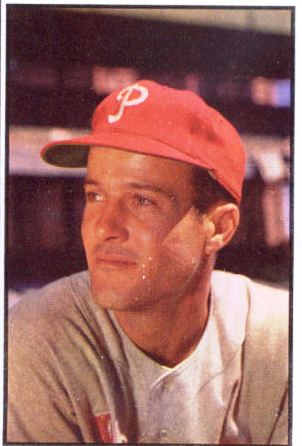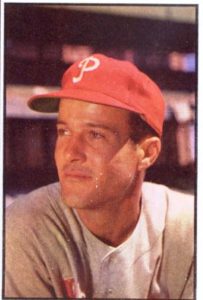Connie Ryan
Louisianan and major league baseball player Connie Ryan played for the New York Giants.

Courtesy of Wikimedia Commons
Connie Ryan. Bowman Gum (Publisher)
Connie Ryan was an All-Star second baseman who spent twelve seasons in the major leagues and another twenty-five years as a manager, coach, and scout. As a rookie with the New York Giants, he took part in a rare triple play; later in his career, Ryan got six consecutive hits in a game to tie a major-league record.
Ryan is perhaps best remembered for an incident that took place at Braves Field in Boston on September 29, 1949. It was raining steadily during an insignificant, end-of-season Ladies Day game. Ryan donned a raincoat while waiting to bat in the on-deck circle. When home plate umpire George Barr saw Ryan’s coat, he threw him out of the game for his not-so-subtle suggestion that the game be called. The game continued even after the Braves’ players built a fire out of programs and newspapers in front of the dugout. While this anecdote is amusing—and many say typical of Ryan—it does not do justice to his career in baseball.
Cornelius Joseph Ryan was born on February 27, 1920, in New Orleans. At Jesuit High School, which also produced future major leaguers Rusty Staub and Will Clark, Ryan was a four-sport star, excelling at baseball, football, basketball, and track. He was also a standout on the American Legion baseball teams of 1935 and 1936.
Ryan briefly attended Louisiana State University but was lured into professional baseball during the Christmas break of his sophomore year to play for the Atlanta Crackers in the Southern Association. He batted .300 in 151 games during the 1941 season with the Crackers and was selected as Atlanta’s Most Valuable Player. On the advice of fellow New Orleanian Mel Ott, Ryan’s contract was purchased by the New York Giants on August 7, 1941. He was later traded to the Boston Braves, where he became the team’s regular second baseman for the 1943 season. He was named to the National League All-Star team in 1944. Two weeks later, on July 25, 1944, Ryan enlisted in the US Navy and served overseas until his discharge in January 1946.
Ryan returned to the Braves and stepped right back in as their regular second baseman. He played for the Boston Braves (1943–1950), the Cincinnati Reds (1950–1951, 1954), the Philadelphia Phillies (1952–1953), and the Chicago White Sox (1953). While with the Phillies, on April 16, 1953, Ryan stroked six consecutive hits in six at-bats in a 14–12 loss to the Pittsburgh Pirates, tying a major-league record. Over twelve seasons Ryan compiled a lifetime batting average of .248 with 56 home runs.
Ryan’s reputation as a tough, heads-up ballplayer kept him in the game as a scout, coach, and manager with the Braves and several other organizations for another twenty-five years. As a scout for the Oakland Athletics, he discovered Louisiana high schooler Vida Blue, who became a six-time All-Star during a seventeen-year major-league career. Later, as the third-base coach for the Atlanta Braves in 1974, Ryan was the first man to shake Hank Aaron’s hand as he rounded third base after hitting his record-setting 715th home run.
Ryan was inducted into the New Orleans Diamond Club Hall of Fame in 1967, the New Orleans Sports Hall of Fame in 1978, the Louisiana Sports Hall of Fame in 1993, and the Greater New Orleans Professional Baseball Hall of Fame in 2007.
He died on January 3, 1996, in Metairie.
